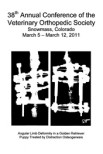Objectives: To assess long-term function in cats following femoral head and neck excision and to investigate if age, weight, sex, breed, outdoor access, multiple injuries, bilateral surgery, complications or physiotherapeutic treatment is associated with long-term function.
Materials and methods: Cats treated with femoral head and neck excision without any postoperative major injury or disease were included in a case-control study. An owner-completed Feline Musculoskeletal Pain Index was used to assess function ≥6 months after surgery. Cats with a score of ≥3 were categorized as having functional impairment (cases). Cats with a score of <3 were categorized as having normal function (controls). Cats' medical records were used to collect information about characteristics, postoperative care and complications.
Results: Thirty-five cats which had undergone uni- or bilateral femoral head and neck excision met the inclusion criteria. Scores ranged from -14 to 11 (median 0, interquartile range 3), 23 (66%) of the cats had normal function and 12 (34%) of the cats had impaired function. Owners of 34 cats (97%) reported good or excellent quality of life. There was an association between being female and a score of ≥3 (odds ratio 24.9; 95% confidence interval: 1.2 to 512.6). No other factors were significantly associated with long-term function.
Clinical significance: At long-term follow-up, owner-reported quality of life was high. However, 34% of cats had functional impairment and female cats had higher odds of impaired function. This suggests that solely owner-reported quality of life should not be used to assess outcomes after femoral head and neck excision.









